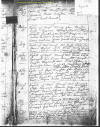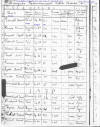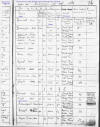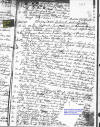| Slovakia Genealogy Research Strategies | ||||||
| Home | Strategy | Place Names | Churches | Census | History | Culture |
| TOOLBOX | Contents | Settlements | Maps | FHL Resources | Military | Correspondence |
| Library | Search | Dukla Pass | ||||
Greek Catholic Church Records
Format and Sample
Slovakia Churches & Their Records | Language / Terminology | Church Slavonic
In the course of research, you will discover that the format of the church records varies from simple, handwritten ledger pages all the way to neat, pre-printed, formal pages. In the most remote of villages, especially those with little financial means, the records are quite simple. This generally applies to most of eastern Slovakia, with the exception of cities and large towns.
Style Although the data included in the church records is fairly consistent throughout the ages, the style and presentation varies, seemingly due to the scribe's own inclination. It is also quite easy to watch the scribe age over time, following the handwriting from year-to-year as it become more sloppy and less steady. At some point, the handwriting actually becomes neat once more, presumably a new priest has arrived.
Deciphering Handwriting - The largest stumbling block most researchers have is not the use of old handwriting styles, which are fairly well documented, but poor penmanship. Almost all documents are written in script/cursive. Poor penmanship includes characters merged and omitted, characters improperly formed, words which trail off, abbreviations used only by the scribe and so on. It is imperative therefore to use other writings by the same scribe as a basis by which to ascertain the correctness in spelling. For most, studying the writing on the same page is most readily useful. When a letter is suspected, search for where the letter is elsewhere used. Seek out written words where you have a high level of confidence. It may require two or three comparisons before you can draw appropriate conclusions.
Language - The Magyars (Hungarians) had varying success in imposing their language on the clerics. They did have much better success at persuading them to use a columnar format, which makes scanning for names, dates and places much easier. In your search, for data prior to 1895, you are likely to find data written in Church Slavonic (utilizing Cyrillic characters) or Magyar. Latin is found quite frequently in Roman Catholic records but infrequently in Greek Catholic records. Slovak is most often found in ledgers from western Slovakia.
Terminology - John Jaso has produce an excellent reference document which shows the key words used in these records in English, Magyar, Latin and Slovak. A second document from Ancestry.com shows terminology in Latin, Polish and Ukrainian to English. FUTURE TO BE ADDED. Thanks to Tim Cuprisin for this reference.
Given Names - Oft times the researcher knows the "Americanized" given name, but is unsure about what the name was, or how it might be recorded. The following references are useful.
Common Foreign Words: English, Magyar, Czech, Slovak, Polish, Slovak & others (FUTURE DOC ADD)
Layout and Examples
I have presented several examples from the church ledger from Zboj, Slovakia. The ledger was used to record information from Zboj and the affiliated parish of Nova Sedlica. I have added select translations for the reader's convenience. Please excuse my extensive use of post-ems, arrows and writings in the margins.
 Image 1:
1799 Baptisms. Church Slavonic, paragraph form. Note how simple and primitive this writing is. The cleric had to draw his own lines. I call this style "paragraph form", as the information, rambles across the page, making it extremely difficult to scan for common information, such as names, date, etc. Knowledge of key words and language is much more important when reading these pages. Note that the dates, shown in the left hand side utilize the Church Slavonic numbering system.
Image 1:
1799 Baptisms. Church Slavonic, paragraph form. Note how simple and primitive this writing is. The cleric had to draw his own lines. I call this style "paragraph form", as the information, rambles across the page, making it extremely difficult to scan for common information, such as names, date, etc. Knowledge of key words and language is much more important when reading these pages. Note that the dates, shown in the left hand side utilize the Church Slavonic numbering system.
Images 2&3: 1869 Marriages, Church Slavonic, tabular form. Two pages. One can quickly see how much easier it is to read this document, even without understanding the language. The groom and bride's name, parents, ages, dates just jump out at you.
Although Latin was little used in the Greek Catholic church, it does occasionally appear. This may be the result of the scribe's education and background.
Image 4: 1811 Baptisms, Latin, paragraph form. Extremely difficult to read. Includes date, given name, parents name and sponsors. Given name is underlined, which appears to be a custom of this particular priest.
Images 5 and 6: 1878 Baptism, Magyar, tabular form. It was a custom to note the date of death, if known for the individual. It was customary to place a cross "+" above the given name and the details of the death noted in the last, "notes" column. This example includes both birth and baptism date. Note that the number of days between birth and baptism varies, probably for practical reasons, such as unavailability of the priest, bad weather and so on.
A Divergence: A curiosity found in a church register
Links to off-site webs will open in a new window. Please disable your pop-up stopper.
Last Update: 15 November 2020 Copyright © 2003-2021, Bill Tarkulich




